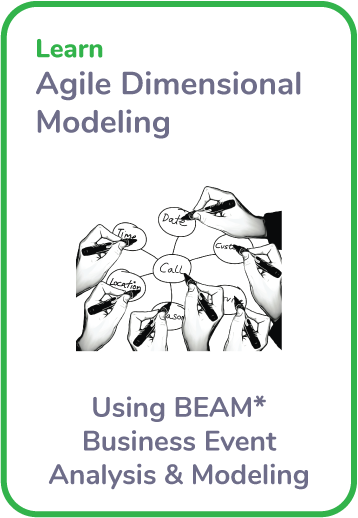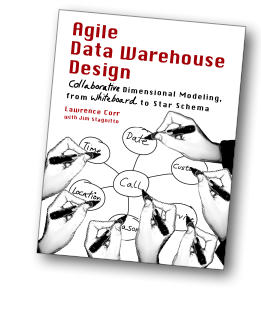
Agile Dimensional Modeling
A 3-day course presented live online and in person internationally by leading data warehousing expert and author Lawrence Corr, covering the latest agile patterns for systematically gathering Business Intelligence (BI) requirements and designing effective Data Warehouse and BI systems.
Register your interest now
The course is delivered virtually as a 3 day course
APPLYING AGILE DATA MODELING IN THE DATA DOMAIN
Visual BI Requirements Gathering and Collaborative Dimensional Modeling
Agile techniques emphasise the early and frequent delivery of working software, stakeholder collaboration, responsiveness to change and waste elimination. They have revolutionised application development and are increasingly being adopted by DW/BI teams.
This course provides practical tools and techniques for applying agility to the design of DW/BI database schemas – the earliest needed and most important working software for BI.
The course contrasts agile and non-agile DW/BI development and highlights the inherent failings of traditional BI requirements analysis and data modeling.
Via class room sessions and team exercises attendees will discover how modelstorming (modeling + brainstorming) data requirements directly with BI stakeholders overcomes these limitations.
Register your interest now
The course is delivered virtually as a 3 day course
DESIGNED FOR PEOPLE IN THE DATA DOMAIN
This course is designed to help
Business analysts, scrum masters, data modelers/architects, DBA’s and application developers, new to DW/BI, will benefit from the solid grounding in dimensional modeling provided.
Experienced DW/BI practitioners will find the course updates their hard-earned industry knowledge with the latest ideas on agile modeling, data warehouse design patterns and business model innovation.
Register your interest now
The course is delivered virtually as a 3 day course
LEARN PROVEN PATTERNS TO COMMON PROBLEMS
What you will learn from this course
✲ Model BI requirements with BI stakeholders using inclusive tools and visual thinking techniques
✲ Rapidly translate BI requirements into efficient, flexible data warehouse designs
✲ Identify and solve common BI problems – before they occur – using dimensional design patterns
✲ Plan, design and incrementally develop BI solutions with agility
Register your interest now
The course is delivered virtually as a 3 day course
FACILITATED BY

Lawrence Corr
Data Modelstormer and Trainer
Lawrence held the position of data warehouse practice leader at Linc Systems Corporation, CT, USA and vice-president of data warehousing products at Teleran Technologies, NJ, USA. In 2000, he was invited by Ralph Kimball to become an associate and teach data warehousing classes for Kimball University in Europe and South Africa during 2000 and 2001. Nowadays he works completely independently through DecisionOne Consulting, based in the UK, providing agile data consultancy and training worldwide.
Register your interest now
The course is delivered virtually as a 3 day course
LEARN THEN DO
Course Syllabus
Time Commitment
The course is run as a 3 day in-person virtual course.
Day 1: Modelstorming – Agile BI Requirements Gathering
Agile Dimensional Modeling Fundamentals
✲ BI/DW design requirements, challenges and opportunities: the need for agility
✲ Modeling with BI stakeholders: the case for collaborative data modeling
✲ Modeling for measurement: the case for dimensional modeling, star schemas, facts & dimensions
✲ Thinking dimensional using the 7Ws (who, what, when, where, how many, why & how)
✲ Business Event Analysis and Modeling (BEAM✲): an agile approach to dimensional modeling
Dimensional Modelstorming Tools
✲ Data stories, themes and BEAM✲ tables: modeling BI data requirements by example
✲ Timelines: modeling time and process measurement
✲ Hierarchy charts: modeling dimensional drill-downs and rollups
✲ Change stories: capturing historical reporting requirements (slowly changing dimension rules)
✲ Storyboarding the data warehouse design: matrix planning and estimating for agile BI development
✲ The Business Model Canvas: aligning DW/BI design with business model definition and innovation
✲ The BI Model Canvas: a systematic approach to BI & star schema design
Day 2: Agile Star Schema Design
Star Schema Design
✲ Test-driven design: agile/lean data profiling for validating and improving requirements models
✲ Data warehouse reuse: identifying, defining and developing conformed dimensions and facts
✲ Balancing ‘just enough design up front’ (JEDUF) and ‘just in time’ (JIT) data modeling
✲ Designing flexible, high performance star schemas: maximising the benefits of surrogate keys
✲ Refactoring star schemas: responding to change, dealing with data debt
✲ Lean (minimum viable) DW documentation: enhanced star schemas, DW matrix
How Much/How Many: Designing facts, measures and KPIs (Key Performance Indicators)
✲ Fact types: transactions, periodic snapshots, accumulating snapshots
✲ Fact additivity: additive, semi-additive and non-additive measures
✲ Fact performance and usability: indexing, partitioning, aggregating and consolidating facts
Day 3: Dimensional Design Patterns
Who & What dimension patterns: customers, employees, products and services
✲ Large populations with rapidly changing dimensional attributes: mini-dimensions & customer facts
✲ Customer segmentation: business to business (B2B), business to consumer (B2C) dimensions
✲ Recursive customer relationships and organisation structures: variable-depth hierarchy maps
✲ Current and historical reporting perspectives: hybrid slowly changing dimensions
✲ Mixed business models: heterogeneous products/services, diverse attribution, ragged hierarchies
✲ Product and service decomposition: component (bill of materials) and product unbundling analysis
When & Where dimension patterns: dates, times and locations
✲ Flexible date handling, ad-hoc date ranges and year-to-date analysis
✲ Modeling time as dimensions and facts
✲ Multinational BI: national languages reporting, multiple currencies, time zones & national calendars
✲ Understanding journeys and trajectories: modeling events with multiple geographies
Why & How dimension patterns: cause and effect
✲ Causal factors: trigging events, referrals, promotions, weather and exception reason dimensions
✲ Fact specific dimensions: transaction and event status descriptions
✲ Multi-valued dimensions: bridge tables, weighting factors, impact and ‘correctly weighted’ analysis
✲ Behaviour Tagging: modeling causation and outcome, dimensional overloading, step dimensions
Course Material
Attendees receive a course workbook, BEAM✲ agile dimensional modeling reference card and a copy of Agile Data Warehouse Design book by Lawrence Corr and Jim Stagnitto.
Register your Interest
Email us on course.beam@agiledata.io or fill out the form.
We will be in touch.
This book describes BEAM✲, an agile approach to dimensional modeling, for improving communication between data warehouse designers, BI stakeholders and the whole DW/BI development team. BEAM✲ provides tools and techniques that will encourage DW/BI designers and developers to move away from their keyboards and entity relationship based tools and model interactively with their colleagues. The result is everyone thinks dimensionally from the outset! Developers understand how to efficiently implement dimensional modeling solutions. Business stakeholders feel ownership of the data warehouse they have created, and can already imagine how they will use it to answer their business questions.


